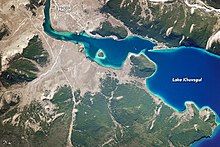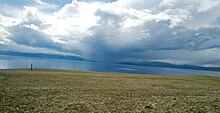Lake Khövsgöl
| Lake Khuvsgul | |
|---|---|
 | |
| Coordinates | 51°06′N 100°30′E / 51.100°N 100.500°E |
| Type | Ancient lake, Rift lake |
| Primary outflows | Eg River |
| Basin countries | Mongolia |
| Max. length | 136 km (85 mi) |
| Max. width | 36.5 km (22.7 mi) |
| Surface area | 2,760 km2 (1,070 sq mi) |
| Average depth | 138 m (453 ft) |
| Max. depth | 267 m (876 ft) |
| Water volume | 480.7 km3 (115.3 cu mi) |
| Surface elevation | 1,645 m (5,397 ft) |
| Islands | Modon khui, Khadan khui, Modot tolgoi, Baga khui |
| Settlements | Khatgal, Khankh |
ᠨᠠᠭᠤᠷ
Lake Khövsgöl is the largest fresh water lake in Mongolia by volume and second largest by area. It is located near the northern border of Mongolia, about 200 km (124 mi) west of the southern end of Lake Baikal. It is nicknamed the "Younger sister" of those two "sister lakes".
The lake's name is also spelled Hovsgol, Hövsgöl, or Khuvsgul in English texts. It is called Хөвсгөл нуур Höwsgöl núr in Mongolian, and is also referred to as Хөвсгөл далай Höwsgöl dalai ("Ocean Khövsgöl") or Далай ээж Dalai éj ("Ocean Mother").
Geography
Lake Khuvsgul is located in the northwest of Mongolia near the Russian border, at the foot of the eastern Sayan Mountains. It is 1,645 metres (5,397 feet) above sea level, 136 kilometres (85 miles) long and 262 metres (860 feet) deep. It is the second-most voluminous freshwater lake in Asia, and holds almost 70% of Mongolia's fresh water and 0.4% of all the fresh water in the world.[1] The town of Hatgal is at the southern end of the lake.
Lake Khuvsgul's watershed is relatively small, and it only has small tributaries. It is drained at the south end by the Egiin Gol, which connects to the Selenge and ultimately into Lake Baikal. Between the two lakes, the water travels a distance of more than 1,000 km (621 mi), and falls 1,169 metres (3,835 feet), although the line-of-sight distance is only about 200 km (124 mi). Its location in northern Mongolia forms one part of the southern border of the great Siberian taiga forest, of which the dominant tree is the Siberian Larch (Larix sibirica),


The lake is surrounded by several mountain ranges. The highest mountain is the Bürenkhaan / Mönkh Saridag (3,492 metres (11,457 feet)), which has its peak north of the lake exactly on the Russian-Mongolian border. The surface of the lake freezes over completely in winter. The ice cover in winter is strong enough to carry heavy trucks; transport routes were installed on its surface as shortcuts to the normal roads. However, this practice is now forbidden to prevent pollution of the lake from both oil leaks and trucks breaking through the ice. It is estimated that 30-40 vehicles have sunk into the lake over the years.[citation needed]
There is a roughly elliptical island in the middle of the lake, named Wooden Boy Island, measuring 3 km east-west and 2 km north-south. It is located about 11 km from the lake's eastern shore, and 50 km north of the town of Hatgal.[2]
Ecological significance


Khuvsgul is one of seventeen ancient lakes in the world, being more than 2 million years old, and the most pristine (apart from Lake Vostok),[3][4] as well as being the most significant drinking water reserve of Mongolia. Its water is potable without any treatment. Hovsgol is an ultraoligotrophic lake with low levels of nutrients, primary productivity and high water clarity (Secchi depths > 18 m are common). Hovsgol's fish community is species-poor compared to that of Lake Baikal. Species of commercial and recreational interest include Eurasian perch (Perca fluviatilis), burbot (Lota lota), lenok (Brachymystax lenok), and the endangered endemic Hovsgol grayling (Thymallus nigrescens). Though endangered by poaching during its spawning runs, the Hovsgol grayling is still abundant throughout much of the lake.[5][6]
The Lake area is a National Park bigger than Yellowstone and strictly protected as a transition zone between Central Asian Steppe and the Siberian Taiga. Despite Hovsgol's protected status, illegal fishing is common and prohibitions against commercial fishing with gillnets are seldom enforced. The lake is traditionally considered sacred in a land suffering from arid conditions where most lakes are salty.
The Park is home to a variety of wildlife such as ibex, argali, elk, wolf, wolverine, musk deer, brown bear, Siberian moose, and sable.
The Hövsgöl (Khövsgöl) Long-term Ecological Research Site (LTERS) was established in 1997 and an extensive research program began soon thereafter. Now part of an international network of long-term study sites, the Hövsgöl LTERS provides a stage for nurturing Mongolia's scientific and environmental infrastructures, studying climate change, and developing sustainable responses to some of environmental challenges facing the lake and its watershed.
Recent studies has identified high levels of plastic pollution (esp. microplastics) in the lake, showing that even small rural populations can cause high plastics pollution levels, as high as elsewhere around the world. [7] [8]
Etymology and transliterations
The name Khövsgöl is derived from Turkic words for "Khob Su Kol, means Lake with Great water"[9] Nuur is the Mongolian word for "lake." There are a number of different transcription variants, depending on whether the Cyrillic "х" is transliterated to "h" or "kh," or whether the "ө" is transliterated to "ö," "o," or "u." Transcriptions from the name in the classical Mongolian script, like Hubsugul, Khubsugul etc. may also be seen.
References
- ^ "The Aquatic Invertebrates of the watershed of Lake Hovsgol in northern Mongolia". Institute for Mongolia Research Guide. Retrieved 2007-07-13.
- ^ "Wooden Boy / Dalan Modon Khuis Island". Google Maps, accessed on 2019-05-24.
- ^ worldlakes.org: lake Hovsgol, retrieved 2007-02-27
- ^ Goulden, Clyde E. et al.: The Mongolian LTER: Hovsgol National Park Archived 2007-09-29 at the Wayback Machine, retrieved 2007-02-27
- ^ DIVER Magazine, March 2009 Archived 2010-02-03 at the Wayback Machine
- ^ Froese, Rainer; Pauly, Daniel (eds.). "Thymallus nigrescens". FishBase. February 2017 version.
- ^ "High-levels of microplastic pollution in a large, remote, mountain lake" Marine Pollution Bulletin, 15 August 2014
- ^ "Why Pristine Lakes Are Filled With Toxins." BBC, 30 April 2018
- ^ Shomfai, David Kara (2003) "Traditional musical life of Tuvans of Mongolia" in Melodii khoomei-III: 40, 80
External links
- New York Times article about kayaking on Khövsgöl
- Limnological Catalog of Mongolian Lakes

